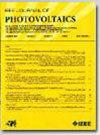Ultrasonic Tinning of Al Busbars for a Silver-Free Rear Side on Bifacial Silicon Solar Cells
IF 2.6
3区 工程技术
Q3 ENERGY & FUELS
引用次数: 0
Abstract
Reducing the silver consumption of photovoltaics (PV) is a major aspect in recent solar cell research. For bifacial PERC+ solar cells silver is used for the front contact. On the rear side aluminum metallization provides the contact to the silicon. The native oxide of aluminum prohibits a standard soldering process. Therefore, rear side silver pads are typically used for the cell-to-cell interconnections with copper wires. Silver can be avoided when using ultrasonic soldering for wetting the aluminum metallization to form tin solder pads. We demonstrate mechanically stable soldering of interconnects to the silver-free solder pads with a median adhesion up to 3 N/mm. We observe a penetration of the native aluminum oxide layer by the ultrasonic tinning process and the formation of metal-to-metal contacts from the aluminum to the solder. Resistance measurements demonstrate a reduced series resistance of the ultrasonically prepared contact when compared with using silver pads. For PERC+ cells, we can thus fully avoid rear side silver pads for a standard stringing process to reduce the silver consumption by 20%–40%. We fabricate mini modules that reach the same efficiency as reference modules with standard silver pads on the rear. The efficiency degradation of the modules with the ultrasonic interconnection is less than 3.6% after 200 humidity-freeze cycles and less than 2.2% after 600 temperature cycles.双面硅太阳能电池背面无银铝母线的超声镀锡
减少光伏电池的银消耗是近年来太阳能电池研究的一个重要方面。对于双面PERC+太阳能电池,银用于前接触。在背面,铝金属化提供了与硅的接触。铝的天然氧化物禁止标准的焊接工艺。因此,背面的银衬垫通常用于与铜线的单元间互连。当使用超声波焊接湿化铝金属化以形成锡焊垫时,可以避免银。我们演示了无银焊盘上互连的机械稳定焊接,中间附着力高达3 N/mm。我们观察到通过超声波镀锡工艺对天然氧化铝层的渗透以及铝与焊料之间金属对金属接触的形成。电阻测量表明,与使用银垫相比,超声波制备的触点的串联电阻降低了。对于PERC+电池,我们可以完全避免使用标准串接工艺的背面银垫,从而减少20%-40%的银消耗。我们制造的迷你模块达到与参考模块相同的效率,后面有标准的银垫。在200次湿冻循环后,超声互连模块的效率下降小于3.6%,在600次温冻循环后,效率下降小于2.2%。
本文章由计算机程序翻译,如有差异,请以英文原文为准。
求助全文
约1分钟内获得全文
求助全文
来源期刊

IEEE Journal of Photovoltaics
ENERGY & FUELS-MATERIALS SCIENCE, MULTIDISCIPLINARY
CiteScore
7.00
自引率
10.00%
发文量
206
期刊介绍:
The IEEE Journal of Photovoltaics is a peer-reviewed, archival publication reporting original and significant research results that advance the field of photovoltaics (PV). The PV field is diverse in its science base ranging from semiconductor and PV device physics to optics and the materials sciences. The journal publishes articles that connect this science base to PV science and technology. The intent is to publish original research results that are of primary interest to the photovoltaic specialist. The scope of the IEEE J. Photovoltaics incorporates: fundamentals and new concepts of PV conversion, including those based on nanostructured materials, low-dimensional physics, multiple charge generation, up/down converters, thermophotovoltaics, hot-carrier effects, plasmonics, metamorphic materials, luminescent concentrators, and rectennas; Si-based PV, including new cell designs, crystalline and non-crystalline Si, passivation, characterization and Si crystal growth; polycrystalline, amorphous and crystalline thin-film solar cell materials, including PV structures and solar cells based on II-VI, chalcopyrite, Si and other thin film absorbers; III-V PV materials, heterostructures, multijunction devices and concentrator PV; optics for light trapping, reflection control and concentration; organic PV including polymer, hybrid and dye sensitized solar cells; space PV including cell materials and PV devices, defects and reliability, environmental effects and protective materials; PV modeling and characterization methods; and other aspects of PV, including modules, power conditioning, inverters, balance-of-systems components, monitoring, analyses and simulations, and supporting PV module standards and measurements. Tutorial and review papers on these subjects are also published and occasionally special issues are published to treat particular areas in more depth and breadth.
 求助内容:
求助内容: 应助结果提醒方式:
应助结果提醒方式:


